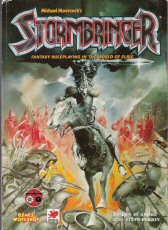Michael A. Stackpole is probably best recognized today as an sf author of such books as
I, Jedi (1998) and his
Star Wars: X-Wing (1996) trilogy. But he got his start in the RPG hobby, specifically with the T&T based game,
Mercenaries, Spies & Private Eyes. As you might guess from the title, the game focuses on contemporary crime and thriller adventures. As Stackpole says in his introduction, "MSPE is a game of two-fisted adventure: part pulp, part mystery, part John Wayne movie and 100% fun."
Cool box cover!
Character creation begins with players choosing their characters background, nationality, ethnicity, etc. before you start rolling the dice. You roll 3d6 for the standard T&T attributes, Strength, Luck, Intelligence, Dexterity, Constitution, Charisma, and Speed. If all the dice come up the same number you roll a further 2d6 and add it on, giving an attribute range of 5-30. Combat adds, the bonuses you get for having certain attributes over 12, are split into Hand-to-hand adds and Missile weapon adds.
The biggest change to the system is the addition of a skill system. In general skills work by adding the skill level to an Attribute when making a saving throw. They are broken up into groups based on a minimum IQ requirement, ranging from IQ 4 skills like Brawling up to IQ 16 skills like Cryptology. There are also Open Skills with no IQ min., covering Special Interests and Occupation skills. All characters start with a number of skill points equal to their Intelligence and each skill costs one or more skill points to acquire. During initial character generation you can also expend skill points to get a hereditary title or psi powers, either of which are then randomly determined.
Combat will be familiar to any T&T player, although Stackpole recommends splitting up the
mêlée into one-on-one fights. The combat round is also restructured to take account of Martial Arts and firearms. Martial Arts are handled in an abstract but very clever fashion that allows a skilled martial artist to take on numerous foes and even disarm gunmen.
Character advancement is handled in familiar T&T fashion using the standard adventure point chart. The main difference is that MSPE characters only gain 2 attribute points after increasing a level. No Marvel superheroes here. In addition, individual skills acquire their own adventure points. That means you have to keep a running total of adventure points for each and every skill you have. That's a lot of book keeping.
There is some GM advice for running mercenary, espionage and detective games. In addition to stats for typical animals and thugs, this section features a detailed section on The Art of Detection which provides a wealth of information for setting up and running mystery scenarios. This is really the heart of the rules and gives the GM invaluable advice about establishing motives, laying out clues, etc., and generally how to run a compelling mystery game.
Other highlights are an extensive equipment list, an excellent recommended reading list, and rules to cover Car Crashes and even Law Enforcement Agencies, which are given attributes like Records, Forensics, Judicial, etc. There's a section called Nightstalkers which gives advice on using the rules to run a pulp-fiction Lost World or horror/science fiction game, which includes stats for dinosaurs and supernatural monsters. Finally there is a selection of sample characters from different time periods, with a few notables like Philip Marlowe and Sherlock Holmes.
These rules are a clever variation on the basic T&T system. The skill system is a welcome addition with lots of options. The stand-out section is The Art of Detection, which is something anyone running a mystery oriented game, whether straight detective or
Call of Cthulhu, should read if they get a chance. The combat rules are also changed for the better. Combat skills like Brawling, Pugilism, Self Defense, and Martial Arts each have a different game effect. Martial Arts is the most ingenious, and captures the feel of
Kung Fu fighting without getting bogged down in details.
Unfortunately this game does get bogged down by adventure point tracking. I don't like experience points to begin with and having to tally them up for each of maybe a dozen skills your character has is a real headache. The other shortcoming of the rules is that the GM sections on running mercenary and espionage scenarios are very anemic. They are sketchy at best and can't compare to the detailed guidelines for running mystery games.
The rulebook cover is kind of plain.
MSPE are must-have rules for T&T players looking to broaden their scope of play. They do and excellent job of expanding the rules and adapting them to a more realistic, contemporary setting. For anyone who runs games that feature mysteries I can't recommend the essay The Art of Detection highly enough. And even if you just want to find out what happens if your leprechaun rogue gets his hands on an Uzi you'll like this game. MSPE is one of those game that deserved a wider audience than it got. If it sounds like your cup of tea I highly recommend it.
Mercenaries, Spies & Private Eyes (Flying Buffalo Inc.) $9.95






























